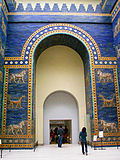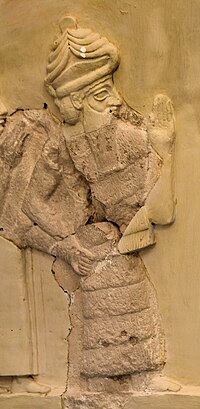 | a crest. The mušḫuššu most famously appears on the Ishtar Gate of the city of Babylon, dating to the sixth century BCE. The form mušḫuššu is the Akkadian... 7 KB (608 words) - 10:03, 15 March 2024 |
 | than the original, in Babylon in 2004 Mušḫuššu dragon in Istanbul, Ancient Orient Museum, Ishtar Gate Mušḫuššu dragon in Istanbul, Ancient Orient Museum... 27 KB (3,509 words) - 04:28, 12 April 2024 |
 | temple Esagila. His symbol is the spade and he is associated with the Mušḫuššu. By the 1st millennium BC, Marduk had become astrologically associated... 48 KB (6,601 words) - 21:19, 26 April 2024 |
 | Mušḫuššu (sirrush) and aurochs on either side of the processional street. Ancient Babylon, Mesopotamia, Iraq.... 98 KB (10,974 words) - 17:26, 26 April 2024 |
The god Marduk and his dragon Mušḫuššu... 25 KB (2,625 words) - 04:19, 9 April 2024 |
gods and the slayer of Tiamat, then was considered the ruler of all gods. Mušḫuššu A creature from ancient Mesopotamian mythology found on Ishtar Gate. A... 44 KB (873 words) - 22:25, 19 February 2024 |
 | The god Marduk and his dragon Mušḫuššu... 46 KB (6,080 words) - 23:25, 26 April 2024 |
 | The dragon Mušḫuššu on a vase of Gudea, circa 2100 BCE.... 40 KB (4,135 words) - 22:58, 22 April 2024 |
Hellenistic period (323 BCE–31 BCE). This creature, known in Akkadian as the mušḫuššu, meaning "furious serpent", was used as a symbol for particular deities... 63 KB (8,126 words) - 16:08, 28 April 2024 |
 | Late Assyrian seal. Worshipper between Nabu and Marduk, standing on their servant dragon Mušḫuššu, eighth century BCE.... 71 KB (8,230 words) - 05:51, 21 April 2024 |
 | Hadad, Leviathan and Yahweh, Tiamat and Marduk (see also Labbu, Bašmu, Mušḫuššu), Illuyanka and Tarhunt, Yammu and Baal in the Baal Cycle etc. The Hebrew... 21 KB (2,285 words) - 10:22, 31 March 2024 |
 | Late Assyrian seal. Worshipper between Nabu and Marduk, standing on their servant dragon Mušḫuššu, eighth century BCE.... 11 KB (1,030 words) - 08:37, 19 January 2024 |
 | apotropaic rituals, Lahmu was associated with other monsters, for example Mushussu, Bashmu (a type of mythical snake), Kusarikku (bison-men associated with... 7 KB (771 words) - 08:49, 1 March 2024 |
009. Wiggermann, Frans A. M. (1989). "Tišpak, his seal, and the dragon mušḫuššu". To the Euphrates and beyond: archaeological studies in honour of Maurits... 29 KB (3,648 words) - 18:30, 26 December 2023 |















